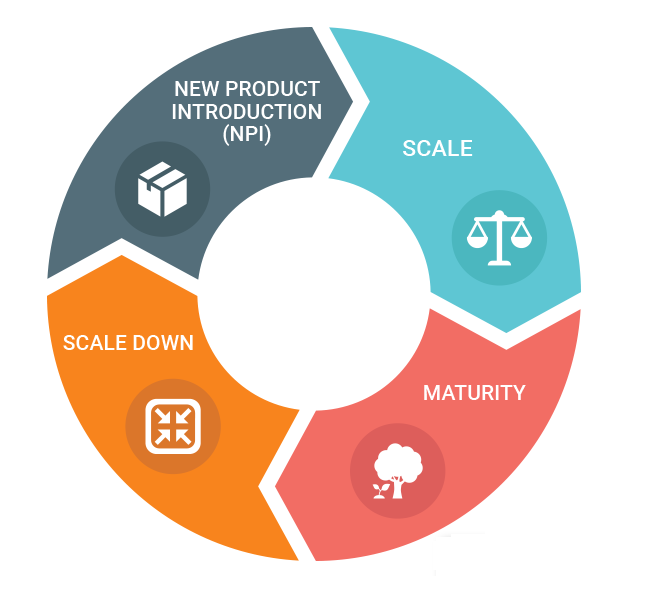Table of Contents
Emerging Future Trends in Product Lifecycle Management Software

Product lifecycle management (PLM) software, a holistic approach to product development, has evolved dramatically over the years. From idea conception to repurposing, reuse, and recycling, it integrates the fundamental aspects of a product’s lifecycle. It brings people, processes, and data together for a flawless collaborative network. During PLM software implementation in your organization, each team must be prepared to face a new approach towards product development.
What is Product Lifecycle?
Many phases are present in a product lifecycle. They are as follows.
-
- Innovation & Design: The primary phase of a product lifecycle is the fundamental concept or idea. Here, exploring new product ideas, selecting the best one for development takes place. Innovators come up with improved product designs and solutions. Full-fledged product designs are in place; necessary materials are chosen, virtual and real prototypes are built for testing until operating conditions are met.
-
- Data Management & Simulation: Data Management lets organizations effortlessly access detailed product design information. The product data is kept safe and accessible by authorized personnel. Testing includes validation, simulation, and optimization tools that can react to real-time data and offer valuable product analysis insights.
-
- Manufacturing & Marketing: The product manufacturing phase is where the production begins. PLM tools like Production Planning help organizations to build more agile and productive production processes. It is the phase that helps to attain a faster time-to-market and manufacture the product successfully for marketing. Marketing strategy formalization based on the key target audience, different communication modes are applied next. PLM solutions offer all-inclusive tools to support marketing teams in pushing products to the market.
-
- Maintenance & Repurposing: This phase includes collect feedback on the product and its performance, maintaining and optimizing future product versions. Maintenance and operations tools offer essential support to your customers.
Benefits of product lifecycle management software
- PLM software helps organizations to maintain value in the product lifecycle by offering suitable tools to close the manufacturing cycle.
- It can also help you recycle, reuse, and repurpose your product’s elements during its lifecycle completion.
- It helps to cut back resource outlay in upcoming product development.
- It optimizes both manual and automated operations and makes sure it is in harmony
- It advances the work output of the employees
- Enables collaborative work environments and provides a higher level of security
- It helps to offer more customized solutions to meet the customers’ requirements
- It makes it easier to build in higher levels of closed-loop quality
Here we have concised a few significant trends that we can look out for with PLM software.
-
- Partnering with Augmented Reality – with augmented reality, development teams can visualize the product from any perspective. It also enables the users to review the product’s virtual prototypes in all possibilities
-
- Bringing together humans and machinery – The ability to connect people with wearables or smartphones can be done by product lifecycle management software configuration. It enhances workforce productivity and overall quality. For instance, in a manufacturing plant, it can measure the new product introductions with digital simulations, thus making ways for probable scenario analysis.
-
- Secure environment – In worldwide manufacturing industries, it is essential to handle massive volumes of confidential data where Intellectual Property is involved. PLM vendors, suppliers, and manufacturers all need trustable product or software development methodologies by having total data access control. PLM software offers a secure collaborative environment for both outsides and within the organization.
-
- Customization made easy – Having a solid foundation of traceability and version control expands the possibility of several variants. It also increases the opportunity to build customer and supplier relations as they are interlinked. It enhances the customization or mass personalization, which can be done by having Product Lifecycle Management tools. Not only can it help with attracting new customers or customer retention, but it can also have a distinct competitive edge.
- Total integration –Software can have a differentiating impact on product lifecycle. As the software complexity in manufacturing upsurges, products need more significant integration levels in the product development process and the entire lifecycle. Keeping both mechanical and electronic software teams in sync and maintaining effective integration among electronic, mechanical, and software product data elements will always be in great demand.
The future
The consumer demand for a combination of product development and global operations may give rise to a brand new interactive experience. From gathering product requirements to predictive maintenance of products and services, Product Lifecycle management software can be the deal. In addition to that, the joint information on virtual and physical products may result in a new demand for data analysis and management.
Final thoughts
Product Lifecycle Management is all about how a product needs to be developed and the various phases it undergoes before it is fully operational for its customers. Having PLM software can provide you with the necessary insights for your employees owing to their tasks and responsibilities.
We help provide the best-customized software development and management solutions that meet your requirements on point. To Reach us, call on +1 408-400-3737 or drop and email at contact@topsinfosolutions.com
Tags